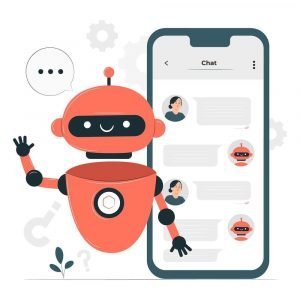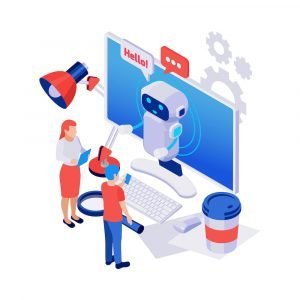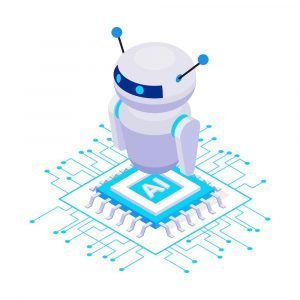Chatbots are no longer a fringe customer support strategy. It’s a technological addition to customer experience design that surpasses expectations when coupled with artificial intelligence, machine learning, and natural language processing. A recent report suggests that the use of chatbots will increase in the coming years and its market to grow at a CAGR of 35 percent in the next four years!
However, many businesses are yet to realize the importance of AI chatbots, let alone how the technology even functions. In this post, we will discuss the ins and outs of AI chatbots. We will share how AI chatbots function, the role of AI in their success, and different AI algorithms used to make chatbots super effective.
What are Chatbots?

How do chatbots use AI to function?
But how do chatbots make the most of artificial intelligence, machine learning, and natural language processing? We have shortlisted four ways AI helps chatbots perform better. Let’s discuss them in detail.
Prepares sales reps for conversion
In one of our previous posts, we discussed how artificial intelligence is capable, but not powerful enough to run all business operations. This pitfall is quite significant and hence, we suggest businesses use AI chatbots carefully. Expecting AI to handle the entire online business-customer conversation is a mistake business managers should avoid.

AI will deliver crucial background information about the customers, which will help save the additional time sales reps take to ask basic questions. This will also allow sales reps to deliver faster resolutions, reduce customer effort, and improve the overall customer experience. AI-driven chatbots can alert customer support or sales teams to take over the chat. This simple utility makes AI chatbots deliver results beyond expectations.
Proper allocation of inquiries
The support teams of medium to large companies are bombarded with inquiries each day. What’s the best way of dealing with such a high number of inquiries without extending the support staff? The very first thing to care about here is the inquiry allocation, i.e., which team is best suited to provide an answer or solution to the inquiry.
This can be extremely challenging, effort-intensive, and time-consuming for a large support team. AI-powered chatbots use natural language processing algorithms to figure out the needs of a user.
AI can gather the required information and determine who to assign the ticket to. Not just that, AI can keep track of the ticket load of each support agent and make sure they receive an equal workload. The idea here is to make chatbots direct the queries to the most qualified agent to resolve the issue. And AI helps them do that efficiently.
Ability to extend pre-emptive support
Anticipation is key to business success. Brands should be able to predict and leverage trends to make a solid market impression. The same principle goes with how companies treat customer support. What if organizations can predict potential issues and prepare for them well in advance?

It uses context, preferences, prior queries, and other factors to alert the support teams in advance. What this does is it helps reduce customer effort as customers get the information related to the issues without even having to ask. Such pre-emptive assistance is an excellent addition to any customer support strategy.
Context is everything
All customers are unique. Indeed, they will have common requirements and expectations. But the way they go about fulfilling them might be different. In such cases, businesses cannot expect to deliver a one-size-fits-all experience and make it work. Generic greetings, standard product recommendations, and a pre-set list of issues do not help customers anymore.
This is precisely where artificial intelligence comes to the rescue. The technology helps brands overcome several limitations. Most importantly, it allows companies to engage with visitors contextually. In other words, artificial intelligence diligently maps the visitor journey, from google search to landing pages!
AI leverages this information to deliver personalized experiences and tailor the conversations to suit the customer. It will help the chatbot make contextual inferences that make the conversation more relevant, attention-grabbing, and more importantly, one that addresses the customer’s needs. This makes it all the more interesting for customers to engage with a chatbot and move further into the sales funnel.
How do AI chatbots work?
Chatbots are a form of conversational AI that is designed to perform routine automated tasks. They are designed to simulate human conversation and use certain triggers and algorithms to make the system work.
How AI chatbots function is quite simple to understand. A user lands on a website, which triggers the chatbots instantaneously. The AI chatbot engages the user in a conversation to learn more about it and the potential issue. After gathering enough information, it does its best to provide a solution by pulling a solution from a pre-set list of resolutions.
If that doesn’t work, the AI chatbot will alert a suitable support agent to resolve the issue. In other words, AI chatbots use an information database and pattern matching using different algorithms.
What are the different AI chatbot algorithms?
As mentioned earlier, AI chatbots function on different algorithms. Let’s discuss these algorithms to understand how they contribute to AI chatbots’ efficiency and accuracy. Some of the most popular AI chatbot algorithms are pattern matching, Naive Bayes, sequence-to-sequence model (seq2seq), recurrent neural networks (RNN), long short-term memory (LSTM), and natural language processing (NLP).
Best programming language for AI chatbot
Well, it can be challenging to call out one programming language to be the best for developing chatbots. This is because different technical circumstances and requirements might need different programming languages. Moreover, developers will have to consider their resources and experiences to make sure they build a functional AI chatbot.
Some of the most used AI chatbot programming languages are Python, Java, Ruby, Lisp, Clojure, CSML, and others. Regardless, Python is the most popular AI chatbot programming language as it naturally supports the Natural Language Toolkit.
Developers also like Ruby as it comes with a wide variety of reliable libraries, a dynamic type system, and automatic memory management. Java is another programming language that facilitates easy AI chatbot development. This is because the language features a standard Widget toolkit allowing for faster and easier development.
Final thoughts!
There you have it. We have shared everything you ever wanted to learn about using AI chatbots. Believe it or not, chatbots have replaced the “Contact Us” buttons on every website. Customers find it easier and more personal to connect with chatbots in order to share feedback, ask queries, and get subjected to super-fast browsing and shopping experiences.
Businesses should ensure they include AI chatbots in their customer support strategy and use the data AI collects to streamline their business operations, especially sales. The idea here is to engage customers and get the conversation going so you have enough details to influence the customer’s purchasing decision. Did you find this post helpful? Let us know in the comments. Also, don’t forget to check out other informative posts in the blog!


